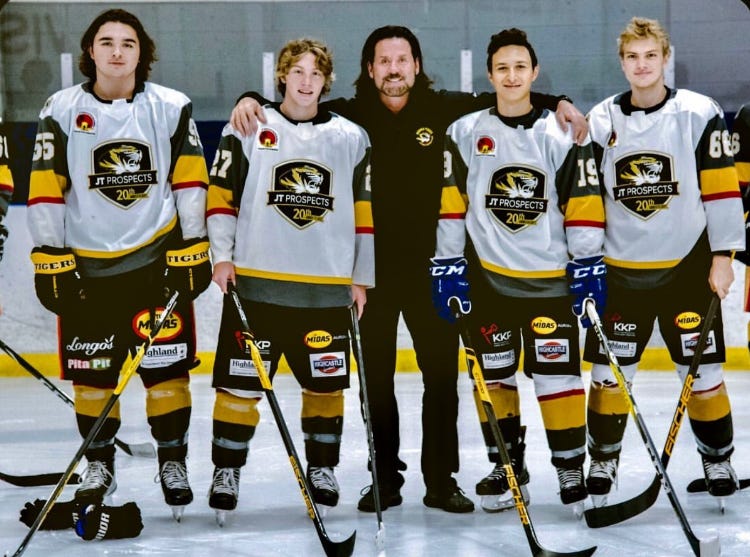Edition #232: Be Careful What You Wish For : Playing At The Next Level Is Not Always What It Is Made Out To Be.
The Jim Thomson story is a reminder that reaching the pinnacle in sport performance maybe a false positive. Remarkably, he has overcome and found a way to make a difference in the community.
Jim Thomson’s story started out not that different from many young Canadians aspiring to reach the highest level of sport.
Coming from modest or difficult upbringing and/or a very clear and passionate focus on playing at the highest level.
This is mirrored by thousands of young men and women across the globe. They see the opportunity to make a living playing a sport, and they pursue that dream with fierce focus and determination.
For any of us parents and/or coaches, the thought likely has crossed our minds. Either from our own youth, or as a coach/parent, when a talented young person crosses our path, or as a parent when our kid expresses interest in “moving up” and playing at the top or next level.
Note: unfortunately more and more parents are interested in Junior “moving up” than Junior might be, and this is a problem to discuss another day.
The reality is that the concept of playing at the next level has become a priority for many and it is not always that healthy of a goal.
For one, the requirements to play at next level when our kids hit 15, 16, and 17 usually requires tons of sacrifice. Sacrifice includes foregoing time with family, a big financial commitment, letting other opportunities go, and social implications.
The cost of prioritizing sport of choice over all else comes at the expense of other interests and skill development. It also can compromise a person’s identity.
See the Ben Fanelli story below as a reminder.
The idea of identifying as an the athlete over all else is a challenging and severe cost, that often hurts when the playing days are done.
The reality is playing at the next level, regardless of who it is, eventually comes to an end.
Competitive sports careers end for all at some point. For most, it ends younger and younger but even for the best, it ends at some point in adult life.
Without perspective and some balance, those few that do work to play into their 20’s and 30’s often struggle when the music stops and the playing career is over.
Jim Thomson grew up in Edmonton and overcame more than most in getting from the trailer park and alcoholic parents to the NHL.
He made up is mind at 14 years old to focus on progressing to the top league in the world , and is one of the few who made it. He played 115 games in the National Hockey League over a 10-year period in the late 1980’s and early 90’s.
In 1984, his coach for the NHL team he was one told him that if he wanted to stay no the team, he needed to fight. That is what would earn his spot. So he did: Thomson fought 41 times that year , including 7 one weekend. Thomson said that being an NHL enforcer led to alcoholism and drug abuse. He went bankrupt and was suicidal.
Today, it is well documented that repeated hits to the head can cause CTE, that leads to depression and other mental health challenges.
While many may dismiss Thomson’s story because no one forced him to fight, the reality is young people focused on their goal will do just about anything to reach it.
The power dynamic means coaches (and parents) are in the delicate position where their demands and expectations can put undue pressure on our young people.
This is a tricky position to say the least and too often abused.
Thomson was not defined by his pro hockey career. His story took a positive turn when he got some help and started to turn his life around in 2005.
He now works with charity groups across Canada to fight homelessness, hunger, illiteracy and addiction. Recently he was inducted into the Aurora (Ontario) Sports Hall of Fame .
He believes that playing in NHL was not his calling, but rather a conduit to help him save lives.
What a turn around from having your entire life’s purpose wrapped into hockey and ended at 28 years old to a higher calling.
Before any parent or coach poo-poos this story with “this would not happen to me or my kid because ….”, the reality is these stories occur to some degree more than you know.
· The 17 year-old baseball player who’s career is over to due to arm injury or “no where else to play”
· The high school senior who has focused years of training to play football at the expense of other things only to realize it’s over.
· The 23 year college senior who now ha Sri pivot to the real world where the focus is not her sport of choice.
· The 22 year old who has the knees or hips and back because of all the “play through it “ decisions that have been made over the last few uears.
I have written about overcoming challenges and being inspired by those who do the same.
The level of commitment and determination to play at the next level is to be admired.
But it should never come at the expense of our identity, self-confidence and relationships outside the sport of choice.
A reminder for coaches and parents to remember balance, remember perspective and be careful what you wish for.
The Hero of His Own Story, Ben Fanelli Now Strives to Inspire and Empower Others to do the Same.
It is the dream of many a young Canadian athlete, to play hockey at the highest level in the NHL. Even though he started to play hockey at the ripe old age of 10, and did not care for it much for it for the first couple of years, Ben Fanelli started to get accolades and enjoy it more into his teens. Before he knew it, it became his focus and his passion…







